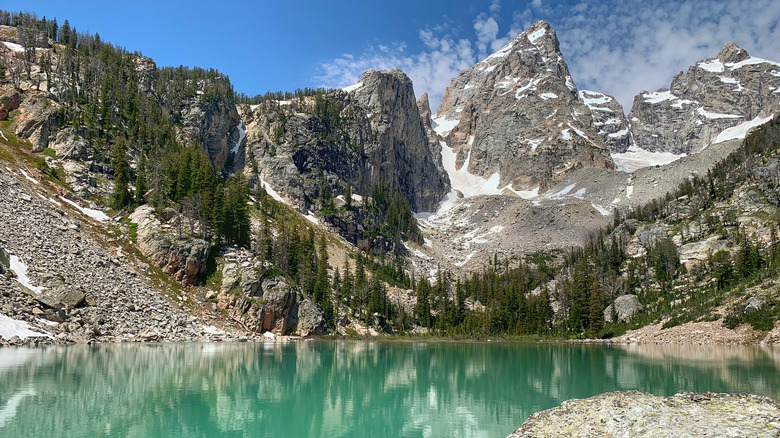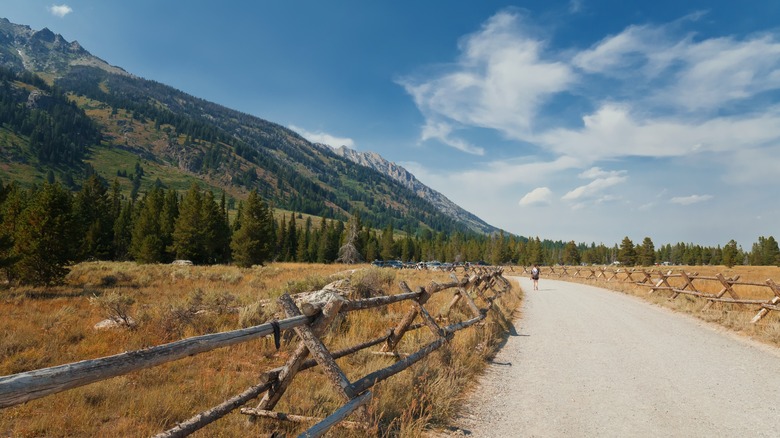One Of Grand Teton National Park's Best Hikes Leads To An Incredible Turquoise Lake
Some of America's best scenic beginner hiking trails are in national parks, and these destinations give everyone the chance to cultivate an appreciation for the outdoors. In places like Grand Teton National Park, an abundance of hiking options can make it difficult to choose which route to explore. How can you decide between a premier lake trail with views of canyons, mountains, and waterfalls and a hike to a beautiful glacier-lined lake? The answer might be to visit neither and instead embark on a journey to see the turquoise waters of Grand Teton's Delta Lake.
While two routes can lead you to Delta Lake, the one people celebrate most begins at the Lupine Meadows Trailhead. Considered a difficult trek, this out-and-back hike treats sightseers to a stunning array of natural wonders. Along the way, visitors can marvel at everything from fields of wildflowers to sightings of deer and bears. Of course, one of the most magnificent views here awaits you at an elevation of over 2,000 feet. That view is of Delta Lake, the mesmerizing alpine beauty that motivates outdoor lovers to take on Grand Teton's backcountry conditions.
Curious to experience that magical sight for yourself? Prepare for the trip by reading up on essential trail info. Plus, discover some important tips that travelers should know before tackling this adventure.
What to expect when hiking from Lupine Meadows to Delta Lake
So, you've heard the hike to Delta Lake is challenging. You know it involves climbing 2,000+ feet in elevation, and you're ready to navigate those conditions in exchange for mind-blowing scenery. Even with all of that in mind, hikers should prepare by learning a little bit more about the trail they'll be exploring.
First, understand the terrain and conditions you'll be up against. Your journey begins at the Lupine Meadows Trailhead, an official Grand Teton National Park area. However, the full hike to Delta Lake is considered an unofficial backcountry trail. As such, it features sections that receive little to no upkeep from the National Park Service (NPS). Visitors should expect the terrain to throw curveballs like rocky fields, slip-inducing dirt sections, and climbs steep enough to aggravate a fear of heights. Wildlife also roams this area, so brush up on how to protect yourself from animals while hiking.
With those details in mind, download or print out the trail map and carefully plan your excursion. Remember, this backcountry path won't be on park maps. For the journey, past visitors recommend downloading the Delta Lake via Lupine Meadows Access map from AllTrails. Paired with a trusty compass and/or GPS receiver, this can lead you on the roughly 7.4-mile roundtrip out-and-back hike to Delta Lake. By following these directions and properly preparing for the voyage ahead, hikers will gain access to unforgettably gorgeous forest, mountain, and alpine lake landscapes. However, those willing to go the extra mile when planning their trip can make the adventure seamless.
How to get the best Grand Teton National Park experience
For the best experience exploring Grand Teton National Park, work out some logistical details ahead of your hike. This is especially important for out-of-town visitors. Why? As the NPS explains, it may be more difficult to breath that this higher elevation for people who aren't used to it. Delta Lake sits at an elevation of about 9,000 feet above sea level, and altitude sickness most commonly occurs at just 8,000 feet. Prepare for these conditions by packing more than enough water, watching your pace, and scheduling in time to acclimatize to the altitude. While acclimatizing, consider staying close to the Lupine Meadows Trailhead at spots like the Jenny Lake Campground, Grand Teton Climbers' Ranch, or Jenny Lake Lodge.
Also make sure to bring adequate hiking gear. This includes broken-in hiking boots that can handle the trail's terrain, socks thick enough to ward off blisters, comfortable layers that will stand up to the weather, a day pack to hold your water and snacks, navigational tools, and emergency items like a first aid kit and bear spray. Additionally, wear sunscreen and pack more with you to reapply. For extra support, hikers may also want to bring trekking poles.
Once you're geared up, plan to head out for your hike as early in the morning as you can. Not only will this help you avoid crowds and ensure enough time for a leisurely trek, but it will also increase your odds of snagging one of the Lupine Meadows Trailhead's limited parking spaces. Spots here go fast (especially from summer through fall), and even early-birds may be surprised at how many people have reached the trail before them.


